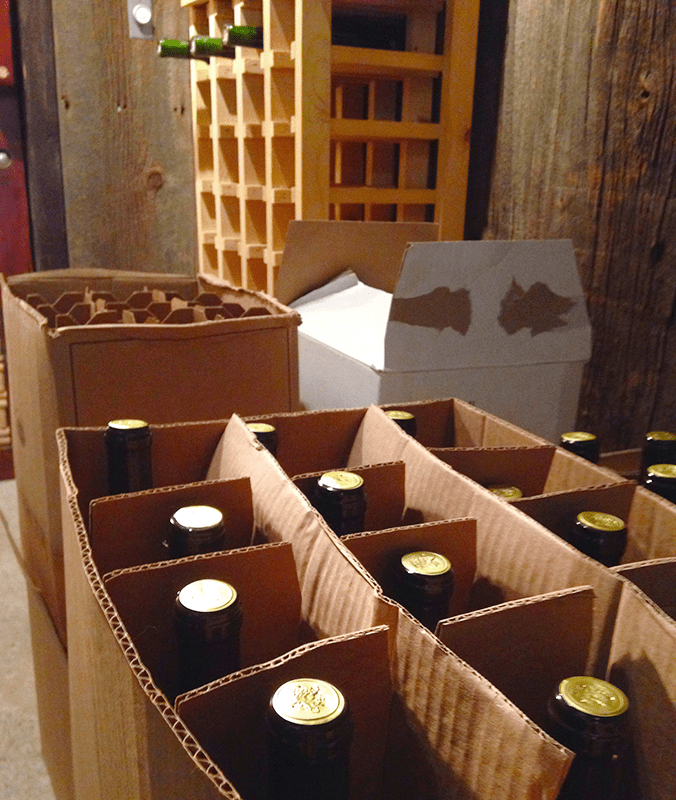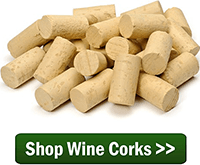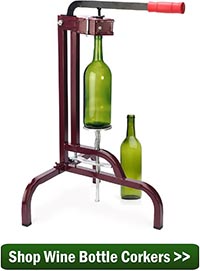 We bottled Lambrusco wine in February. We tasted 2 months later and decided it was just not going to be sweet enough. Is it ok to remove the corks-put back into clean container and sweeten more with the wine conditioner and then re-bottle the wine?
We bottled Lambrusco wine in February. We tasted 2 months later and decided it was just not going to be sweet enough. Is it ok to remove the corks-put back into clean container and sweeten more with the wine conditioner and then re-bottle the wine?
Name: Barbara
State: Kentucky
—–
Hello Barbara,
Unfortunately, we get asked this question quite often. I’ll start off by giving you the short answer, “yes, re-bottling wine is possible”.
What you are asking to do may sound simple in principal, but there are some considerations that need to be thought through first:
- It is important to know that you will not be able to reuse the wine corks that you’re are pulling out of the wine bottles. There is no way to sanitize the wine corks completely after wine has saturated into them. Also, the corks have been put through a corking once so they would be more difficult to press into the wine bottle without destroying them. For these reasons when re-bottling wine you will need to consider the original wine corks a loss and use new ones.
- The wine bottles will need to be cleaned and and sanitized again, so this will be extra work beyond just decanting and re-bottling the wine. I recommend using Basic A for this purpose. The amount of time it will take you to empty all the wine bottles, sweeten the wine and then bottle the wine back up is too long to leave them sitting, exposed to air with the residue of wine in them.
 After stirring in the Wine Conditioner to sweeten the wine, you will also need to add a sulfite back into it, just as you did the first time you bottled the wine. You can use either Campden tablets, sodium metabisulfite or potassium metabisulfite. Both the glugging of the wine as it pours out of the bottle into a bucket and the stirring of the wine as the Wine Conditioner is being blended will saturate air into the wine. This is something that can cause your wine to oxidize. Oxidation can potentially cause the wine to turn brown or orange in color and give it a smell and taste that resembles raisins or caramel. By adding the sulfites you will easily drive the oxygen back out of the wine.
After stirring in the Wine Conditioner to sweeten the wine, you will also need to add a sulfite back into it, just as you did the first time you bottled the wine. You can use either Campden tablets, sodium metabisulfite or potassium metabisulfite. Both the glugging of the wine as it pours out of the bottle into a bucket and the stirring of the wine as the Wine Conditioner is being blended will saturate air into the wine. This is something that can cause your wine to oxidize. Oxidation can potentially cause the wine to turn brown or orange in color and give it a smell and taste that resembles raisins or caramel. By adding the sulfites you will easily drive the oxygen back out of the wine.
- One last thing: when re-bottling wine I would also recommend adding a dose of ascorbic acid to this wine in such a situation. Ascorbic acid is good for raising the acidity level of a wine without raising the acid taste or tartness. The ascorbic acid will help by consuming free oxygen they may still be left in the wine. This will also help to hinder any oxidation of the wine.
 Having considered all the above, you can also sweeten the wine as you drink it. I realize that the esthetics of sweetening a wine in a carafe or a glass as-you-go is not all that sophisticated nor satisfying, but it will save you a lot of work and still get you your sweet wine. A bottle of honey works well for such an occasion.
Having considered all the above, you can also sweeten the wine as you drink it. I realize that the esthetics of sweetening a wine in a carafe or a glass as-you-go is not all that sophisticated nor satisfying, but it will save you a lot of work and still get you your sweet wine. A bottle of honey works well for such an occasion.
Regardless of what path you decide to take, just realize the re-bottling wine is something that can be done. Just be sure to follow the precautions listed above.
Happy Winemaking,
Ed Kraus
—–
Ed Kraus is a 3rd generation home brewer/winemaker and has been an owner of E. C. Kraus since 1999. He has been helping individuals make better wine and beer for over 25 years.

SWEETEN AS YOU GO!
I sometimes use liquid stevia. I use a few drops in a bottle and it works great.
I feel that you should test the wine in the 2nd fermentation for the sweet ness and adjust it at that point
Hello
I wanted to ask if you add ascorbic acid wouldn’t that affect the PH?
Thanks
Steve, ascorbic acid does lower the pH, but such a small amount is needed to reduce the effects of oxidation that it is of little consequence.
when adding sugar to sweeten the wine start with 1/2 of what your think you’ll need. measure the sepicific gravity or bix but not by taste. The first 1/2 cup of sugar raised it 3 steps the 2nd 1/2 sent the sp over 12. Then wait a day to measure or add more sugar. I got 5 gallons of plum syrup at 12% alcohol. Refermation didn’t happen beause of the potassium sorbate. opps Dave
If you are going to add in sweetener to any wine, you need to add in Potassium Sorbate as well as sulphite. If you are adding 50 mls. of conditioner per batch of wine ( 5 gallons), there is not enough of the sorbate in it to prevent re-fermentation. 50 mls. will give a smoothness and reduce the rough edges. 100 mls. will definitely make it smooth and you might detect a touch of sweetness. 150 mls. will be off dry or a light sweetness. Most conditioners recommend 60mls.per 1 US Gallon. This will make the wine way to sweet.
Can’t get the first article to come up. Tried 8 different times. Would like to hear why the use of blenders aren’t any good
Mike, we are sorry that there is an issue with the article links in our recent email newsletter. The following link will take you directly to the article.
Using A Blender To Crush Wine Making Fruit
http://www.eckraus.com/blog/using-a-blender-to-crush-wine-making-fruit
Hello Ad and friends,
Your suggestion to sweeten the wine in carafe is best choice, indeed.
I am adding also a slice of lime or grapefruit and it gives wine more aroma.
I have question re: sanitation. Are there any alternatives to potassium / sodium metabisulfite in wine making? Merry Christmas and Happy New Year!!!
will the wine taste better if it is sweetened enough while ageing or will it taste the same sweeting as you uncork and use
Carol, there really is not a difference in how the wine will taste after it has aged.